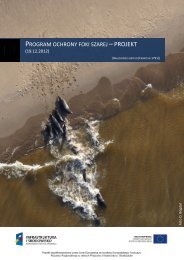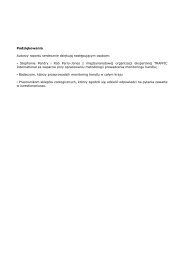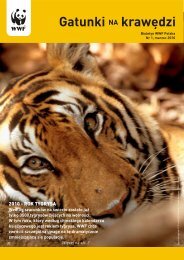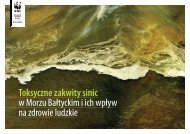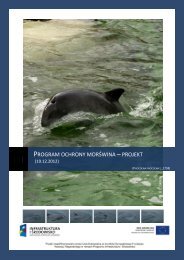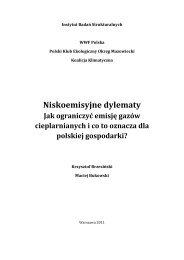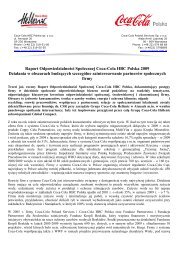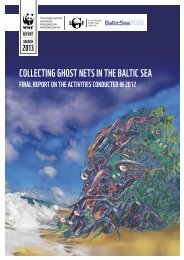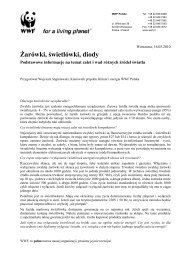EcologicalFootprint: Futurescenarios(continued)EcosystemEcosystemservicesProvisioningservicesRegulatingservicesSupportingserviceswith the scenarios in food <strong>and</strong> energy were combined with the estimatesof the IPCC (IPCC, 2007b) <strong>and</strong> a l<strong>and</strong> suitability model (Global Agro-Ecological Zones – GAEZ) to predict changes in the area <strong>and</strong> suitabilityof l<strong>and</strong> for growing crops (Fischer et al., 2008).A dynamic complex of plant, animal <strong>and</strong> micro-organism communities<strong>and</strong> their non-living environment interacting as a functional unit.The Millennium Ecosystem Assessment distinguished supporting,provisioning, regulating <strong>and</strong> cultural services that contribute to humanwell-being (Millennium Ecosystem Assessment, 2005a; b). Theseservices are defined in the four panels below:Goods obtained directly from ecosystems (e.g., food, medicine, timber,fibre <strong>and</strong> bioenergy).Benefits obtained from the regulation of natural processes (e.g., waterfiltration, waste decomposition, climate regulation, crop pollination <strong>and</strong>regulation of some human diseases).Regulation of basic ecological functions <strong>and</strong> processes that are necessaryfor the provision of all other ecosystem services (e.g. nutrient cycling,photosynthesis <strong>and</strong> soil formation).HDIsimply not available <strong>and</strong> many opportunities remain inaccessible. Butthe realm of human development goes further: Essential areas of choice,highly valued by people, range from political, economic <strong>and</strong> socialopportunities for being creative <strong>and</strong> productive; to enjoying self-respect,empowerment <strong>and</strong> a sense of belonging to a community. The concept ofhuman development is a holistic one, putting people at the centre of allaspects of the development process. (Source: Human DevelopmentReport webpage).The HDI – Human Development Index – is a summary composite indexthat measures a country’s average achievements in three basic aspects ofhuman development: health, knowledge <strong>and</strong> a decent st<strong>and</strong>ard of living.The HDI contains three components:1. Health: Life expectancy at birth (number of years a newborn infantwould live if prevailing patterns of mortality at the time of birthwere to stay the same throughout the child’s life).2. Knowledge: A combination of the adult literacy rate <strong>and</strong>the combined primary, secondary <strong>and</strong> tertiary grossenrolment ratio.3. St<strong>and</strong>ard of living: GDP per capita (PPP US$).(Source: Human Development Report webpage).Cultural servicesGlobal hectare(gha)Hum<strong>and</strong>evelopmentPsychological <strong>and</strong> emotional benefits gained from human relationswith ecosystems (e.g., enriching recreational, aesthetic <strong>and</strong> spiritualexperiences).A productivity weighted area used to report both the <strong>biocapacity</strong> of theEarth, <strong>and</strong> the dem<strong>and</strong> on <strong>biocapacity</strong> (the Ecological Footprint). Theglobal hectare is normalized to the area-weighted average productivity ofbiologically productive l<strong>and</strong> <strong>and</strong> water in a given year. Because differentl<strong>and</strong> types have different productivity, a global hectare of, for example,cropl<strong>and</strong>, would occupy a smaller physical area than the much lessbiologically productive pasture l<strong>and</strong>, as more pasture would be needed toprovide the same <strong>biocapacity</strong> as one hectare of cropl<strong>and</strong>. Because worldbioproductivity varies slightly from year to year, the value of a gha maychange slightly from year to year (Global Footprint Network, 2012).Human development is a process of “enlarging” people’s <strong>choices</strong>.Enlarging people’s <strong>choices</strong> is achieved by exp<strong>and</strong>ing human capabilities<strong>and</strong> functioning. At all levels of development the three essentialcapabilities for human development are for people to lead long <strong>and</strong>healthy lives; to be knowledgeable; <strong>and</strong> to have a decent st<strong>and</strong>ard ofliving. If these basic capabilities are not achieved, many <strong>choices</strong> aresimply not available <strong>and</strong> many opportunities remain inaccessible. ButHuman development is a process of “enlarging” people’s <strong>choices</strong>.Enlarging people’s <strong>choices</strong> is achieved by exp<strong>and</strong>ing human capabilities<strong>and</strong> functioning. At all levels of development the three essentialcapabilities for human development are for people to lead long <strong>and</strong>healthy lives; to be knowledgeable; <strong>and</strong> to have a decent st<strong>and</strong>ard ofliving. If these basic capabilities are not achieved, many <strong>choices</strong> areInequalityadjustedHumanDevelopmentIndex (IHDI)Living PlanetIndex (LPI)The IHDI is a measure of the level of human development of people ina society that accounts for inequality. Under perfect equality, the IHDIis equal to the HDI; but it falls below the HDI when inequality rises. Inthis sense, the IHDI is the actual level of human development while theHDI can be viewed as an index of the potential human developmentthat could be achieved if there is no inequality. The IHDI accounts forinequality in HDI dimensions by “discounting” each dimension’s averagevalue according to its level of inequality.The average loss in the HDI due to inequality is about 23 percent – that is, adjusted for inequality, the global HDI of 0.682 in 2011would fall to 0.525. Countries with less human development tend to havegreater inequality in more dimensions – <strong>and</strong> thus larger losses in hum<strong>and</strong>evelopment.This new version of the HDI was developed for the 2011 HumanDevelopment Report (UNDP, 2011) <strong>and</strong> at the time of publication, theadjustment has been applied to 134 countries. For this definition <strong>and</strong>more information, see the IHDI homepage.The LPI reflects changes in the health of the planet’s ecosystems bytracking trends in over 9,000 populations of vertebrate species. Muchas a stock market index tracks the value of a set of shares over time asthe sum of its daily change, the LPI first calculates the annual rate ofchange for each species’ population in the dataset (example populationsare shown in Figures 4-6). The index then calculates the average changeacross all populations for each year from 1970, when data collectionbegan, to 2008, the latest date for which data is available (Collen et al.,2009 <strong>and</strong> see Annex 1 for more details).WWF Living Planet Report 2012 page 148 Annex: Technical notes <strong>and</strong> data tables page 149
NationalAccounts ReviewCommitteeNational FootprintAccountsNatural capitalOvershootSustainabledevelopmentVirtual waterWater FootprintZNDDGlobal Footprint Network’s scientific advisors who develop <strong>and</strong> endorserecommendations for methodological changes to the EcologicalFootprint Accounts (Global Footprint Network, 2012).The central data set that calculates the footprints <strong>and</strong> biocapacities ofthe world, <strong>and</strong> roughly 150 nations from 1961 to the present (generallywith a three-year lag due to data availability). The ongoing development,maintenance <strong>and</strong> upgrades of the National Footprint Accounts arecoordinated by Global Footprint Network <strong>and</strong> its 70+ partners (GlobalFootprint Network, 2012).Natural capital can be defined as all of the raw materials <strong>and</strong> naturalcycles on Earth. Footprint analysis considers one key component:life-supporting natural capital, or ecological capital for short. Thiscapital is defined as the stock of living ecological assets that yield goods<strong>and</strong> services on a continuous basis. Main functions include resourceproduction (such as fish, timber or cereals), waste assimilation (suchas CO2 absorption or sewage decomposition) <strong>and</strong> life support services(such as UV protection, biodiversity, water cleansing or climate stability).Global overshoot occurs when humanity’s dem<strong>and</strong> on the natural worldexceeds the biosphere’s supply, or regenerative capacity. Such overshootleads to a depletion of Earth’s life-supporting natural capital <strong>and</strong> abuild-up of waste. At the global level, <strong>biocapacity</strong> deficit <strong>and</strong> overshootare the same, since there is no net-import of resources to the planet.Local overshoot occurs when a local ecosystem is exploited more rapidlythan it can renew itself (Global Footprint Network, 2012).Development that meets the needs of the present without compromisingthe ability of future generations to meet their own needs.The “virtual water content” of a product is the same as its “WaterFootprint”. The Water Footprint of a product (a commodity, goodor service) is the volume of freshwater used to produce the product,measured at the place where the product was actually produced. It refersto the sum of the water used in the various steps of the production chain.The Water Footprint of an individual, community or business is definedas the total volume of freshwater that is used to produce the goods <strong>and</strong>services consumed by the individual or community, or produced by thebusiness. The Water Footprint of a nation is defined as the total amountof water that is used to produce the goods <strong>and</strong> services consumed by theinhabitants of the nation.WWF defines ZNDD as: no net forest loss through deforestation <strong>and</strong>no net decline in forest quality through degradation; <strong>and</strong> stresses that:(a) most natural forest should be retained – the annual rate of loss ofnatural or semi-natural forests should be reduced to near zero; <strong>and</strong> (b)any gross loss or degradation of pristine natural forests would need tobe offset by an equivalent area of socially <strong>and</strong> environmentally soundforest restoration.List of abbreviationsASC Aquaculture Stewardship CouncilBRIICS Brazil, Russia, India, Indonesia, China, South AfricaCBD Convention on Biological DiversityCLUM Country L<strong>and</strong> Use MatrixCONAGUA Mexican National Water Commission (Comisión Nacional del Agua)EF Ecological FootprintEFR Ecological Footprint ReportESA European Space AgencyESRI Environmental Systems Research InstituteFAO United Nations Food <strong>and</strong> Agricultural OrganizationFSC Forest Stewardship CouncilGAM General Additive ModelingGAEZ Global Agro Ecological ZonesGDP Gross Domestic ProductGha Global HectaresGHG Greenhouse GasGNI Gross National IncomeHDI Human Development IndexICCAT International Commission for the Conservation of Atlantic TunasIEA International Energy AgencyIFC International Finance CorporationIHDI Inequality-adjusted Human Development IndexIIASA International Institute for Applied Systems AnalysisIPCC International Panel on Climate ChangeIUCN International Union for the Conservation of NatureMEA Millennium Ecosystem AssessmentMSC Marine Stewardship CouncilLPI Living Planet IndexLPR Living Planet ReportOECD Organization for Economic Cooperation <strong>and</strong> DevelopmentREDD Reducing Emissions from Deforestation <strong>and</strong> Forest DegradationTEEB The Economics of Ecosystems <strong>and</strong> <strong>Biodiversity</strong>TOE Tons of Oil EquivalentUNDP United Nations Development ProgrammeUNFCCC United Nations Convention on Climate ChangeUNFPA United Nations Population FundWBCSD World Business Council for Sustainable DevelopmentWF Water FootprintWHO World Health OrganizationWMO World Meteorological OrganizationWWF World Wide Fund for NatureZNDD Zero Net Deforestation <strong>and</strong> Forest DegradationZSL Zoological Society LondonWWF Living Planet Report 2012 page 150 Annex: Technical notes <strong>and</strong> data tables page 151



